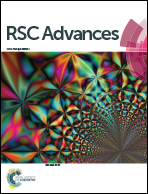Direct synthesis of cucurbit[5]uril-anchored polyacrylic acid microspheres and potential applications in selective sorption†
Abstract
A one-pot strategy was employed to synthesize a series of cucurbit[5]uril-anchored (Q[5]-anchored) polymers with high yields. The acrylic acid (AA) monomer, an ammonium persulfate salt (APS) initiator, and an oxidant were used in the polymerization. The Q[5]-anchored polyacrylic acid aggregates (Q[5]-PAA) have been characterized by 1H NMR, 13C NMR, 2D NMR, FTIR, TGA, GPC, TEM and SEM measurements. The experimental results confirm that PAA chains can be grafted to Q[5] in a controlled manner through an in situ radical polymerization approach. The effects of acrylic acid and Q[5] feed mass and APS concentration on the formation of polymer nanocapsules have been investigated. The experiments reveal that the feed mass of acrylic acid greatly influences the properties of Q[5]-PAA when the ratio of Q[5]/APS is fixed at 0.5. In particular, when APS/Q[5] = 46 and 72, vesicle structures are observed in the Q[5]-anchored polymers. Moreover, such polymer nanocapsules show selective absorption of some volatile compounds, particularly methanol.
![Graphical abstract: Direct synthesis of cucurbit[5]uril-anchored polyacrylic acid microspheres and potential applications in selective sorption](/en/Image/Get?imageInfo.ImageType=GA&imageInfo.ImageIdentifier.ManuscriptID=C5RA03418C&imageInfo.ImageIdentifier.Year=2015)

 Please wait while we load your content...
Please wait while we load your content...